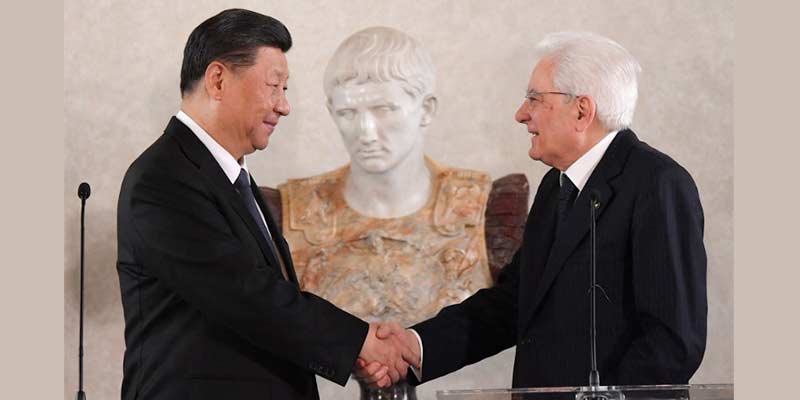- World
- Mar 23
Big boost for China as Italy joins BRI
Italy and China want to revive the spirit of the ancient Silk Road by deepening their trade and investment ties, Chinese President Xi Jinping said during a trip to Rome that has raised eyebrows in Washington. Xi is set to sign a deal that will see Italy become the first member of the Group of Seven (G7) major industrialised nations to join China’s Belt and Road infrastructure project (BRI).
Despite criticisms, Beijing has been steadily gathering support for its BRI project, which aims to weave a network of ports, bridges and power plants linking China with Africa, Europe and beyond. Italy’s involvement would give China a crucial inroad into western Europe and a symbolic boost in its economic tug-of-war with the US.
Italy would be the first G7 member to join BRI, following Portugal’s embrace of the initiative in December. It appears to be driven partly by hopes that Chinese investment in Italy’s ports might help revive the country’s traditional role as a key link in trade between the East and West.
As President Donald Trump squares off with China over trade and other issues, gaining Italy’s support is a coup for Beijing.
What is the big initiative?
The BRI is an ambitious effort announced in 2013 to improve regional cooperation and connectivity on a trans-continental scale. The initiative aims to strengthen infrastructure, trade, and investment links between China and some 65 other countries that account collectively for over 30 per cent of global GDP, 62 per cent of population, and 75 per cent of known energy reserves. The BRI consists primarily of the Silk Road Economic Belt, linking China to Central and South Asia and onward to Europe, and the New Maritime Silk Road, linking China to the nations of Southeast Asia, the Gulf countries, North Africa, and on to Europe. Six other economic corridors have been identified to link other countries to the BRI project.
China wants to attract non-Chinese investors but that has happened only on a few of the hundreds of projects, which range from oil drilling in Siberia to construction of ports in Southeast Asia, railways in Eastern Europe and power plants in West Asia.
China says some 150 countries have signed Belt and Road related agreements since the programme’s launch more than five years ago. A major conference is planned next month in Beijing, marking further expansion of the initiative.
Beijing has marketed the initiative as a way to give some of the world’s neediest countries a leg-up, helping them gain access to more trade and investment. But it also helps Chinese companies tap new markets for their products while, inevitably, helping Beijing amass greater global influence.
Some governments including the US, Japan and India worry that Beijing is trying to build a China-centered sphere of influence that would undermine their own sway, pulling developing nations into so-called “debt traps”, that would give China ever-more control over their territories and economies.
China already has made inroads into Eastern Europe through investments in railways, ports and steel mills. That’s stirred fears of a growing divide within the 28-member EU between its wealthier and poorer members. Some also worry Chinese-led projects might undercut the bloc’s standards on transparency.
As the US takes on long-standing complaints of Chinese intellectual property theft and unfair trade practices, a Chinese win in Italy could boost Beijing’s arguments that it is ultimately a force for good in the global economy. China’s official position is that BRI is solely an economic initiative with no political motives. Xi said in a speech last year that even as China moves closer to the centre of the world stage, it will never seek hegemony.
What are the roadblocks?
The initiative has run into some roadblocks in the past year, as the Chinese economy cooled and the US and others accused Beijing of saddling developing countries with too much debt. Some governments including Thailand, Tanzania, Sri Lanka and Nepal have scrapped, scaled back or renegotiated projects amid complaints that they are too costly and give too little work to local contractors. Last year, Malaysian Prime Minister Mahathir Mohamad cancelled projects including a $20 billion railway he said his country cannot afford. And in December 2017, Sri Lanka yielded control of its port of Hambantota to a Chinese state-owned company after falling behind in paying $1.5 billion in loans from Beijing.
Why is India opposing BRI?
India has signalled that it will boycott China’s second Belt and Road Forum, saying no country can participate in an initiative that ignores its core concerns on sovereignty and territorial integrity. India boycotted the first forum in 2017 after protesting over the controversial China-Pakistan Economic Corridor, which is being laid through the Pakistan-occupied Kashmir, overriding New Delhi’s sovereignty concerns.

